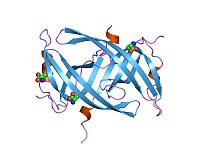
Photo from wikipedia
Abstract Rim1 is the mitochondrial single-stranded DNA binding protein in Saccharomyces cerevisiae and functions to coordinate replication and maintenance of mtDNA. Rim1 can form homo-tetramers in solution and this species… Click to show full abstract
Abstract Rim1 is the mitochondrial single-stranded DNA binding protein in Saccharomyces cerevisiae and functions to coordinate replication and maintenance of mtDNA. Rim1 can form homo-tetramers in solution and this species has been assumed to be solely responsible for ssDNA binding. We solved structures of tetrameric Rim1 in two crystals forms which differ in the relative orientation of the dimers within the tetramer. In testing whether the different arrangement of the dimers was due to formation of unstable tetramers, we discovered that while Rim1 forms tetramers at high protein concentration, it dissociates into a smaller oligomeric species at low protein concentrations. A single point mutation at the dimer–dimer interface generates stable dimers and provides support for a dimer–tetramer oligomerization model. The presence of Rim1 dimers in solution becomes evident in DNA binding studies using short ssDNA substrates. However, binding of the first Rim1 dimer is followed by binding of a second dimer, whose affinity depends on the length of the ssDNA. We propose a model where binding of DNA to a dimer of Rim1 induces tetramerization, modulated by the ability of the second dimer to interact with ssDNA.
Journal Title: Nucleic Acids Research
Year Published: 2018
Link to full text (if available)
Share on Social Media: Sign Up to like & get
recommendations!